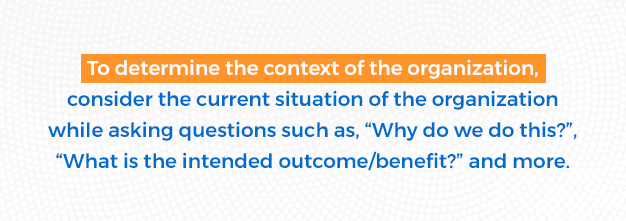ISO 45001 - Context of the Organization
As with the other recently revised ISO management standards (ISO 9001:2015 / ISO 14001:2015) the context is one of the cornerstones of the revision and potentially generated the highest number of questions from clients. In response to these questions we have created this article.
To give some background on this topic, in March 2018, OHSAS 18001 was officially superseded by ISO 45001. As with other ISO management standards — such as ISO 9001:2015 and ISO 14001:2015 — ISO 45001 is structured according to the same Annex SL format. While this helps with integration and implementation, one new part of ISO 45001 requires organizations to determine their context.

Mentioned specifically in section four of ISO 45001, the context of an organization is now a requirement for occupational health and safety — or OH&S — management systems that want to be compliant with the new ISO standard.
What Is The Context Of The Organization?
Over the past decade, the effects of e-commerce and internet trading alone have greatly impacted how organizations conduct business. And as companies grow and break down former borders to commerce, their context changes as well. As a result, with OH&S management, there are many issues with wider and more complex impacts to consider than ever before.To understand the context of the organization, consider the overall environment that the organization functions in. The context of the organization is a consideration of the internal and external influences the organization is required/chooses to respond to in relation to its OH&S management system. The influences can be positive or negative and may come from a range of sources.
Determining The Context Of The Organization

To determine the context of the organization, start with the organization as it stands now, and carefully consider the current situation of the organization while asking the following questions:
- Why do we do this? Why is this important to us and/or the organization?
- What is the intended outcome / benefit? What do we hope to accomplish?
- Where and who is the requirement coming from? Is it a legal/compliance issue or something else?
- How do we meet / deliver this requirement? What’s the most fitting action to take?
- How do we know it has been successful in achieving the intended outcome? How do we verify our results?
- What if we haven’t delivered what was required — what happens next?
External Factors
Critical external factors can have a great impact on an organization’s success as well as the health and safety of its workers. Some common external factors include the following:- Legal and statutory requirements
- Governing agency and certification parameters
- Cultural, regional and local issues
- Political and economic policies
- Key industry drivers
- Competition and market conditions
Internal Factors
Of course, there are just as many key internal factors to consider. A few of the most common are:- Organization governance and structure
- Roles and responsibilities
- Existing knowledge of product / services / activities
- Existing arrangements with workers
- Culture
- Strategy of the organization
- Policies and objectives
- Group organizations
- Shareholders and stakeholders
- Existing technologies, techniques and resources
- Workers
Consideration of the above will aid the identification of interested parties and if you then ask the questions identified in the earlier section, the process for the context has been established. Decisions must be made as to which of the identified needs or expectations are or could become statutory or other requirements.
Benefits Of Defining The Context Of The Organization
There are several distinct benefits of defining the context of the organization. First of all, it helps the organization comply with all applicable laws and regulations of its industry. This, in turn, helps protect the business from a legal and financial liability point of view.
In addition, it helps enhance the safety and well-being of the workforce. In today’s rapidly changing technological environment, workers are working alongside computers and robotics — and they face a variety of health issues ranging from stress and depression to burnout and repetitive strain injuries. It’s more important than ever before to ensure that an OH&S management plan is relevant, practical and targeted to injury and illness prevention.
Scope Of The OHS Management System
The scope can only be determined once the context has been considered. The scope will need to be documented information within the management system and must be factual statement representing the operations included in the OHS system.We hope this very brief overview has been useful in clarifying what could be required to meet some of the requirements of the new ISO 45001 standard.
Sign up to our ISO 45001 Toolkit to ensure you get all the latest updates and any useful downloads straight to your inbox.
Sign Up For NQA’s Newsletter — InTouch — To Stay Informed

Sign up now and receive our free monthly e-zine — InTouch — that will provide you with timely articles, insights and guidance related to standards, certifications and management systems. Get top-notch advice from standards experts sharing best practices and techniques, as well as alerts regarding the latest changes to environmental — as well as health and safety — legislation.
To learn more about NQA and what our services can do for your organization, contact us today.
